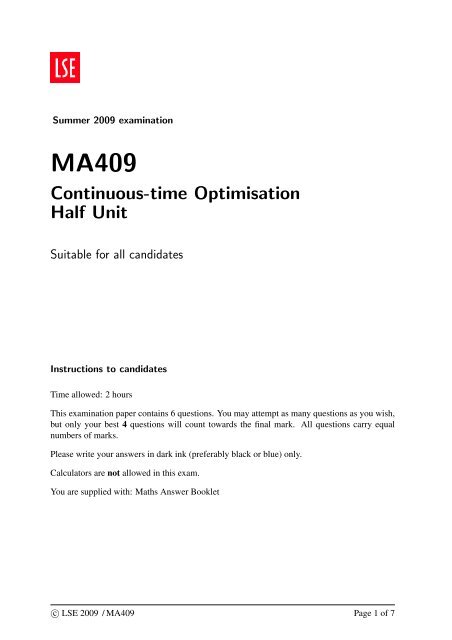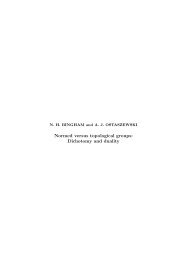MA409 Continuous-Time Optimisation
MA409 Continuous-Time Optimisation
MA409 Continuous-Time Optimisation
Create successful ePaper yourself
Turn your PDF publications into a flip-book with our unique Google optimized e-Paper software.
Summer 2009 examination<br />
<strong>MA409</strong><br />
<strong>Continuous</strong>-time <strong>Optimisation</strong><br />
Half Unit<br />
Suitable for all candidates<br />
Instructions to candidates<br />
<strong>Time</strong> allowed: 2 hours<br />
This examination paper contains 6 questions. You may attempt as many questions as you wish,<br />
but only your best 4 questions will count towards the final mark. All questions carry equal<br />
numbers of marks.<br />
Please write your answers in dark ink (preferably black or blue) only.<br />
Calculators are not allowed in this exam.<br />
You are supplied with: Maths Answer Booklet<br />
c○ LSE 2009 / <strong>MA409</strong> Page 1 of 7
1.<br />
(a) State the Fundamental Lemma of the Calculus of Variations.<br />
(b) Let f : R 3 → R be a continuous function with continuous partial derivatives with respect to<br />
the first and second argument.<br />
Consider the problem of extremizing the functional<br />
F(x) =<br />
∫ T<br />
0<br />
f (x(t),ẋ(t), t) dt,<br />
subject to the end-point restrictions x(0) = a, x(T ) = b, where a,b are constants and x :<br />
[0,T ] → R is a continuously differentiable function.<br />
(i) Use the Fundamental Lemma to derive the Euler-Lagrange equation corresponding to this<br />
problem.<br />
(ii) If the end-point value x(T ) is unrestricted, deduce a condition satisfied by x(T ).<br />
(c) Consider the problem of finding the continuously differentiable function minimizing the<br />
functional<br />
subject to x(0) = 1.<br />
F(x) =<br />
∫ T<br />
0<br />
(<br />
x(t) 4 + x(t) 2 ẋ(t) 2) dt,<br />
Write down the first integral of the Euler-Lagrange equation for this problem and hence, using<br />
(c)(ii), solve the problem.<br />
c○ LSE 2009 / <strong>MA409</strong> Page 2 of 7
2.<br />
(a) Let X be a normed vector space of continuously differentiable functions on [0,1]. Let the<br />
function f : R 3 → R have continuous partial derivatives.<br />
Consider the problem of extremizing over X<br />
F(x) =<br />
∫ 1<br />
subject to G(x) = 0,<br />
0<br />
f (x,ẋ,t)dt,<br />
where G is a differentiable function from X to a normed vector space Y . Suppose that the<br />
relative stationarity condition holds at x = ξ , that is, for each h in X<br />
DG(ξ )h = 0 ⇒ DF(ξ )h = 0.<br />
Deduce a Lagrange Multiplier Theorem. You should define any duality notions which you call<br />
upon.<br />
(b) Let X comprise the continuously differentiable functions (x(t),y(t)) on [0,1], i.e. with<br />
values in R 2 , and Y = R.<br />
Apply the method of Lagrange multipliers to solve the constrained problem of maximizing<br />
∫ 1<br />
where r > 0 is a constant, subject to<br />
with x(t) ≥ 0,y(t) ≥ 0.<br />
0<br />
e −rt (x(t) 1/2 + 2y(t) 1/2 ) dt,<br />
∫ 1<br />
0<br />
(x(t) + y(t)) dt = 1,<br />
c○ LSE 2009 / <strong>MA409</strong> Page 3 of 7
3.<br />
A dynamical system has governing equation:<br />
ẍ = 4ẋ − 3x + u, |u| ≤ 1.<br />
(a) State the Pontryagin Principle in a form suited to deriving the minimum time trajectory<br />
taking the system from a given initial state to rest at the origin (i.e. x = 0, ẋ = 0).<br />
(b) Use the Pontryagin Principle to show that the time-optimal control is of ‘bang-bang type’<br />
and that at most one switch of control takes place.<br />
(c) Find the singular points in the (x,ẋ) phase plane corresponding to the two constant controls<br />
u = ±1, and the linear trajectories through them. By considering the eigenvalues of the<br />
associated first-order formulation, say what shape of trajectories to expect in general.<br />
(d) Sketch the trajectories u = ±1 which pass through the origin of the phase plane.<br />
(e) Sketch the switching curve and indicate how it is used to obtain optimal trajectories from<br />
controllable initial states (x,ẋ) in the phase plane.<br />
c○ LSE 2009 / <strong>MA409</strong> Page 4 of 7
4.<br />
Consider the problem of finding<br />
∫ T<br />
S(c,T ) = min{ (x 4 + x 2 ẋ 2 ) dt : x is continuously differentiable on [0,T ] and x(0) = c}.<br />
0<br />
(a) Show that the Bellman equation for the problem is<br />
0 = min{(c 4 + c 2 v 2 ) + v ∂S<br />
v<br />
∂c − ∂ S<br />
∂T }.<br />
(b) Verify that S(c,T ) = c 4 S(1,T ) and hence find S(1,T ).<br />
(c) Deduce that<br />
lim S(1,T ) = 1<br />
T →∞ 2 .<br />
(d) Consider now the problem of finding<br />
∫ ∞<br />
V (c) = min{ (x 4 + x 2 ẋ 2 ) dt : x is continuously differentiable on [0,∞) and x(0) = c}.<br />
0<br />
Deduce from (c) that the optimal trajectory satisfies ẋ = −x and hence find the optimal trajectory<br />
assuming x(0) = 1.<br />
c○ LSE 2009 / <strong>MA409</strong> Page 5 of 7
5.<br />
Consider the problem of finding, for t ≥ 0,<br />
∫ ∞<br />
C(x,t) = min{E[ e −ρs (aXs 2 + bu 2 s )ds] : u s is continuous for s ≥ t},<br />
t<br />
where for s ≥ t the stochastic process X s is defined by the initial condition X t = x and the<br />
equation<br />
dX s = u s ds + σX s dz s ,<br />
with z s a standard Wiener process, and a,b,ρ,σ positive constants.<br />
(a) Assuming that the function C is twice continuously differentiable, show that C satisfies the<br />
Hamilton-Jacobi-Bellman equation.<br />
ρC(x,0) = min[ax 2 + bu 2 + u ∂C(x,0) + 1<br />
u<br />
∂x 2 σ 2 x 2 ∂ 2 C(x,0)<br />
∂x 2 ].<br />
(b) Find C(x,0), assuming it is of the form C(x,0) = Ax γ for some A and γ. You should identify<br />
A and γ.<br />
(c) Express the value function of the optimization problem, C(x,t), in terms of C(x,0).<br />
c○ LSE 2009 / <strong>MA409</strong> Page 6 of 7
6.<br />
Let C [0,1] denote the normed vector space of continuous functions on [0,1] with values in<br />
R with the maximum norm ||x|| ∞ . Let C 1 [0,1] denote the subspace of C [0,1] consisting of<br />
functions x whose derivative ẋ is continuous. Define a norm on C 1 [0,1] as follows:<br />
||x|| 1 := ||x|| ∞ + ||ẋ|| ∞ .<br />
(a) Let F be a function from C 1 [0,1] to C [0,1]. Define (i) the Gateaux derivative D h F(x)<br />
(the directional derivative) in direction h, and (ii) the Fréchet derivative (the strong derivative)<br />
DF(x). Show that if the strong derivative exists, then for all h in C 1 [0,1]<br />
D h F(x) = DF(x)h.<br />
(b) For the function S : C 1 [0,1] → C [0,1] defined by<br />
S(x)(t) = ẋ(t) 3 ,<br />
explain why the Gateaux derivative D h S(x) is the function y such that y(t) = 3ẋ(t) 2 ḣ(t).<br />
Show further that if ||x|| 1 ≤ 1 and ||h|| 1 ≤ ε < 1, then<br />
||S(x + h) − S(x) − D h S(x)|| ∞ ≤ 4ε||h|| 1 .<br />
Conclude that the function S(x) has a strong derivative.<br />
(c) The real-valued functions G and F are defined on C 1 [0,1] × R by<br />
G(x,τ) = (x(0),x(τ) − q(τ)),<br />
F(x,τ) =<br />
∫ τ<br />
0<br />
f (x,ẋ,t)dt,<br />
where the function q : R → R is differentiable and the function f : R 3 → R is continuous, and<br />
differentiable in its first two arguments.<br />
(i) Let u denote a vector (h,σ) in C 1 [0,1]×R with 0 < σ < 1. Suppose that 0 < τ < 1 and that<br />
x is in C 1 [0,1]. Compute the directional derivatives D u G(x,τ) and D u F(x,τ).<br />
(ii) For the problem of maximizing F on C 1 [0,1] × R subject to G = 0, it is known that at the<br />
optimum (x,τ) the condition<br />
DG(x,τ) = 0 =⇒ DF(x,τ) = 0,<br />
holds. Deduce the transversality condition at τ :<br />
f − (ẋ − ˙q) fẋ = 0.<br />
You may assume that for an optimal pair (x,τ), the Euler-Lagrange equation is satisfied for<br />
0 ≤ t ≤ τ.<br />
c○ LSE 2009 / <strong>MA409</strong> Page 7 of 7
















